30 Feet From Stop Sign

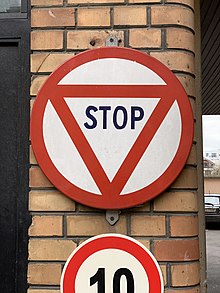
A circular stop sign in France
A stop sign is a traffic sign designed to notify drivers that they must come to a complete terminate and brand sure the intersection is safely clear of vehicles and pedestrians before continuing past the sign.[1] In many countries, the sign is a red octagon with the word Terminate, in either English or the national language of that particular state, displayed in white or yellow. The Vienna Convention on Road Signs and Signals as well allows an culling version: a cherry-red circumvolve with a red inverted triangle with either a white or xanthous groundwork, and a black or dark blue Cease. Some countries may also apply other types, such equally Japan's inverted red triangle finish sign. Particular regulations regarding advent, installation, and compliance with the signs vary by some jurisdiction.
Design and configuration [edit]
The 1968 Vienna Convention on Route Signs and Signals allows for two types of stop sign as well every bit several adequate variants. Sign B2a is a red octagon with a white stop legend. The European Addendum to the convention also allows the background to exist "light yellow". Sign B2b is a red circumvolve with a red inverted triangle with either a white or xanthous background, and a black or night bluish terminate legend. The Convention allows for the discussion "STOP" to exist in either English or the national language of the particular country. The finalized version by the Un Economic and Social Council's Conference on Route Traffic in 1968 (and in force in 1978) proposed standard stop sign diameters of 600, 900 or 1200 mm.
The U.k. and New Zealand stop signs are 750, 900 or 1200 mm, according to sign location and traffic speeds.[ii] [3]
In the United States, cease signs are thirty inches (75 cm) across opposite flats of the red octagon, with a iii / 4 -inch (2 cm) white border. The white majuscule stop legend is 10 inches (25 cm) alpine.[4] [5] Larger signs of 35 inches (xc cm) with 12-inch (30 cm) legend and 1-inch (ii.five cm) edge are used on multi-lane expressways. Regulatory provisions exist for extra-big 45-inch (120 cm) signs with 16-inch (40 cm) legend and 1+ 3 / 4 -inch border for use where sign visibility or reaction distance are express, and the smallest permissible stop sign size for general usage is 24 inches (60 cm) with an viii-inch (20 cm) legend and 5 / 8 -inch (1.v cm) border.[six] The metric units specified in the US regulatory manuals are rounded approximations of United states of america customary units, not exact conversions.[5] [seven] The field, legend, and border are all retroreflective.
-
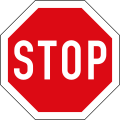
B2a
-

Acceptable variant of B2a in the European Annex
-

B2b
-
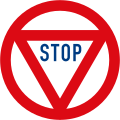
Acceptable variant of B2b
-

Acceptable variant of B2b
-

Adequate variant of B2b
History [edit]

Yellow U.S. 1924–1954 end sign
The get-go ever terminate sign was created by Detroit constabulary sergeant Harold "Harry" Jackson, who was working every bit a traffic guard at a decorated city intersection. One of the cross streets had a particularly depression-visibility turn entering the intersection, almost ever forcing Harry to slow down and hold back the traffic inbound from that street. Looking for ways to brand his job easier, he took a rectangular piece of plywood, cut off the corners to give it a distinct shape, wrote "STOP" over the center and placed facing the street. He noticed that his innovation improved the overall traffic flow through the intersection. Later on he shared his experience with boyfriend officers at a meeting, the practise started to spread across the city intersections.[8] Adjacent year, finish signs were adopted across Michigan.[nine] [ better source needed ] [x] The first ones had black lettering on a white background and were 24 by 24 inches (61 cm × 61 cm), somewhat smaller than the current sign. As cease signs became more widespread, a rural-dominated committee supported past the American Association of State Highway Officials (AASHO) met in 1922 to standardize them and selected the octagonal shape that has been used in the United States always since. The unique 8-sided shape of the sign allows drivers facing the back of the sign to identify that oncoming drivers have a stop sign and prevent defoliation with other traffic signs. Some other consideration of the AASHO was visibility and commuter literacy, as summarized in subsequent Motorway Commission reports in the states of the U.S., was that the goal for signs "standardized throughout the Wedlock" was that "The shape of the sign will point what it will mean. This has been worked up very carefully by the all-time qualified men in the country and men who have made a thorough report of this question. Information technology has been found that so many people have trouble in reading the sign that the shape of the sign is very much more of import than the reading thing on it."[11]
The octagon was also chosen then that it could be identified hands at night since the original signs were not reflective.[ citation needed ] The more urban-oriented National Conference on Street and Highway Condom (NCSHS) advocated a smaller red-on-xanthous stop sign.[9] These 2 organizations eventually merged to grade the Joint Committee on Uniform Traffic Control Devices, which in 1935 published the first Transmission on Uniform Traffic Control Devices for Streets and Highways (MUTCD) detailing the end sign's specifications.
The MUTCD'due south stop sign specifications were altered eight times between 1935 and 1971. From 1924 to 1954, stop signs bore a red or blackness end legend on a yellow field.[ix] Yellow was chosen considering fade-resistant red materials were not available.[12] [13] Retro-reflective or cocky-lit signs were permitted in the 1935 MUTCD; retro-reflective ones were outset required by the 1948 edition of the MUTCD, which as well called for a 2+ 1 / 2 -human foot (0.76-metre) height from the road crown to the bottom of the stop sign.[14] The 1954 MUTCD newly specified a white terminate legend on a red field, and increased the mount height specification to 5 feet in rural areas.[9] Red traffic lights signify terminate, then the new specification unified red as a stop signal whether given by a sign or a light. The current mounting meridian of 7 ft (2.13 k) was first specified in 1971.[9]

Us mandate, international adoption [edit]
The MUTCD end sign was already widely deployed in the Us when the utilise of other types of stop signs was eliminated in 1966.[nine] In 1968, this sign was adopted past the Vienna Convention on Route Signs and Signals as role of United Nations Economical Committee for Europe'southward effort to standardize road travel beyond borders. The Convention specifies that terminate exist written in English or the national linguistic communication, and also allows a round sign with ruby legend. 40 European countries[15] are party to the convention.
Stop signs around the world [edit]
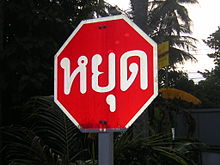

Blue and light-green stop signs are sometimes used on private belongings in Hawaii[sixteen]
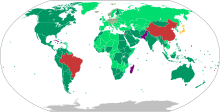
World map of countries' current and historical stop sign shapes.
Octagonal (eight sides)
Historically circular, now octagonal
Triangular (3 sides)
Historically triangular, now octagonal
Circular
Unknown
The red octagonal field with white English-language stop legend is the virtually common stop sign used around the world, but it is non universal; Japan uses an inverted solid red triangle, for example, and Zimbabwe until 2016 used a disc bearing a black cross. Moreover, there are many variants of the scarlet-and-white octagonal sign. Although all English-speaking and many other countries use the word stop on stop signs, some jurisdictions use an equivalent discussion in their primary linguistic communication instead, or in addition; the utilise of native languages is common on U.S. native reservations, particularly those promoting language revitalization efforts,[ citation needed ] for example, and Israel uses no discussion, but rather a pictogram of a hand in a palm-frontward "stop" gesture.
Asia [edit]
Countries in Asia by and large employ a native word, often in a non-Latin script.
Europe [edit]
Countries in Europe generally accept finish signs with the text stop, regardless of local language. There were some objections to this when introduced effectually the 1970s, but at present this is accepted. Turkey (and the unrecognized Turkish Republic of Northern Cyprus) is a notable exception to this, instead using the Turkish word for stop: "dur".
Latin America [edit]
In Spanish and Portuguese-speaking Caribbean and Due south American countries (Argentina, Bolivia, Brazil, Chile, Colombia, Republic of cuba, Dominican Republic, Republic of ecuador, Paraguay, Peru, Puerto Rico, Uruguay, and Venezuela), signs bear the fable pare ("finish" in Portuguese and Spanish). Mexico and Central American countries deport the legend alto ("halt") instead.
Canada [edit]


In the Canadian province of Quebec, modernistic signs read either arrêt or finish ;[17] still, it is not uncommon to see older signs containing both words in smaller lettering.[18] Both cease and arrêt are considered valid French words, with France actually using the word "Cease" on its stop signs, and the Role québécois de la langue française (OQLF) notes that the utilize of "stop" on stop signs is attested in French since 1927.[19] At the time of the debates surrounding the adoption of the Charter of the French Language ("Bill 101") in 1977, the usage of "stop" was considered to be English and therefore controversial; some signs were occasionally vandalized with crimson spray paint to turn the word stop into "101".[xx] However, it was subsequently officially determined by the OQLF that "stop" is a valid French word in this context, and the older dual arrêt / end usage is therefore considered redundant and therefore deprecated (à éviter). Newly installed signs thus utilise merely one word, more than unremarkably only arrêt in Québec, while stop is seen in predominantly English-speaking areas. Bilingual signs with stop arrêt are still placed in English-speaking areas of New Brunswick and Manitoba; the Acadian regions of Nova Scotia, and Prince Edward Island; on federal property in the National Upper-case letter Region; and at all border crossings of the Canada–United States border.[ citation needed ] On Starting time Nations or Inuit territories, stop signs sometimes use the local aboriginal language in addition or instead of English language, French, or both, such as Inuktitut notkagit . All other English-speaking areas of Canada utilise stop .
Other countries [edit]
- Standard arabic-speaking countries apply قف qif (except for Lebanon, which only uses stop since 2018).
- Republic of india, Australia, New Zealand, United Kingdom, Indonesia, The Philippines, Pakistan, The European Economic Area, Fiji, Singapore, and the U.s.a. apply the standard version of the sign.
- Armenia uses ԿԱՆԳ kang and stop .
- Brazil and Castilian-speaking Caribbean area and South American nations use pare
- Canada uses both the standard version of the sign and multilingual stop signs.
- Cambodia uses ឈប់ chhob .
- China and Taiwan use 停 tíng , except that Mainland Communist china'due south sign has a bolder word.
- Cuba uses a version of the B2b terminate sign that says pare
- Ethiopia uses a version of the sign that says ቁም ḳumə and stop
- Hong Kong SAR uses a version of the sign that says 停 tíng , and stop
- Iran and Afghanistan apply ایست ist
- Israel and Palestine uses a version of the stop sign with a raised mitt.
- Japan uses a triangular sign that says 止まれ tomare and stop
- Lao people's democratic republic uses ຢຸດ yud
- Malaysia and Brunei employ berhenti
- Mexico and other Central American nations utilize alto
- Mongolia uses ЗОГС zogs
- Myanmar uses ရပ် raut
- Nigeria uses a variant of the B1a stop sign with a xanthous typeface.
- Democratic people's republic of korea uses 섯 sŏt
- Portuguese-speaking countries with the exception of Brazil use the standard version of the sign
- South Africa, like nearly nations, uses the B2a cease sign.
- South Korea uses 정지 jeongji and cease
- Spain uses stop
- Russian-speaking countries use either stop or стоп (i.e. stop transliterated into Russian), with the latter mark the place where vehicles should wait at traffic lights
- Thailand uses หยุด yùd
- Tonga uses a version of the B2b cease sign with the text overlapping the triangle inside the circumvolve.
- Turkey uses dur
- United Arab Emirates, Oman, Qatar, Kuwait, Bahrain and Saudi Arabia use a multilingual terminate sign that says both قف qif and stop except Tunisia uses a unlike version of the sign.
- Vanuatu uses a circular cerise stop sign.
- Vietnam uses a version of the stop sign with smaller text: stop .
-

Argentina, Bolivia, Brazil, Republic of chile, Colombia, Dominican Republic, Republic of ecuador, Paraguay, Republic of peru, Puerto Rico, Uruguay, Venezuela
-
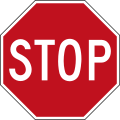
Commonwealth of australia, Canada (except Quebec), EEA, Fiji, Republic of india, Indonesia, Lebanon, New Zealand, Pakistan, Philippines, Singapore, United kingdom of great britain and northern ireland, The states
-

Armenia
-

Kingdom of bhutan
-

Negara brunei darussalam
-
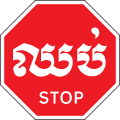
Kingdom of cambodia
-
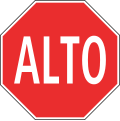
Costa rica, El Salvador, Guatemala, Honduras, United mexican states, Nicaragua, Panama
-

Republic of cuba
-

People's republic of china
-

Egypt, Libya, Morocco, Saudi Arabia, Sudan
-
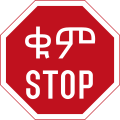
Federal democratic republic of ethiopia
-

France, Ireland, Portugal, Espana
-
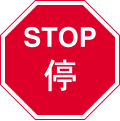
Hong Kong SAR
-

Islamic republic of iran, Afghanistan
-

Israel, Palestine
-

Republic of india (Panjabi areas)
-

Japan
-

Laos
-

Malaysia
-

Mongolia
-

Myanmar
-
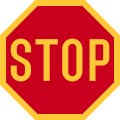
Nigeria
-

North Korea
-

Province of Quebec, Canada (in Cree)
-
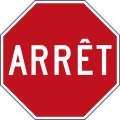
Province of Quebec, Canada (in French)
-

Russia, Ukraine, Belarus, Azerbaijan, Kazakhstan, Kyrgyzstan, Uzbekistan, Lithuania
-
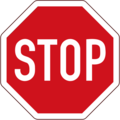
South Africa
-
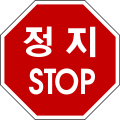
South Korea
-

Taiwan
-
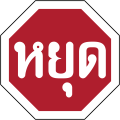
Thailand
-

Tonga
-
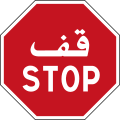
Tunisia
-
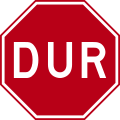
Turkey
-

Hashemite kingdom of jordan, United Arab Emirates, Oman, Qatar, Kuwait, Bahrain, Kingdom of saudi arabia
-

Vanuatu
-

Vietnam
Historical gallery [edit]
The following are some older stop sign designs, used before the Vienna Road Traffic Convention standardized the pattern:
-

Germany (before 1937)
-

Germany (1938-1953 for FRG/1956 for German democratic republic)
-
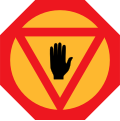
Finland (1957-1971)
-
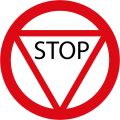
Hellenic republic (before 1982)
-

Italy (1959-1990)
-
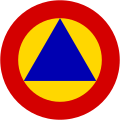
Romania (1957-1961)
-

U.k. (1965-1975)
-
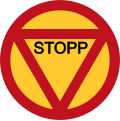
Sweden (1951-1976)
-

United States (1924-1954)
-
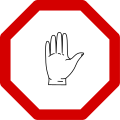
Ethiopia
-
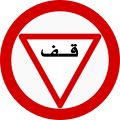
Great socialist people's libyan arab jamahiriya
-

Republic of zambia
-
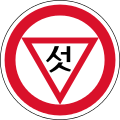
Democratic people's republic of korea
-

Nihon (1950-1960)
-

Nippon (1960-1963)
-

Thailand
-

Commonwealth of australia (1940-1956)
-

Pakistan
-
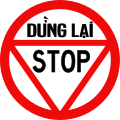
South Vietnam (1955-1975)
-

South Africa
-

Spain (1962-1976)
Application [edit]
Stop signs are used all over the world, but almost countries outside of North America and S Africa use relatively few of them considering all-fashion stops are never used and in some countries are legally prohibited.[21] In a majority[ citation needed ] of Central Asian countries, also as Republic of cuba in North America, junctions without traffic lights or roundabouts are controlled by cease signs on minor roads and by white, yellow and black priority diamond signs on the major road. In Europe and Australia, stop signs are restricted to places where coming to a dead stop is deemed necessary because of severely limited sight lines. At the vast majority of minor intersections in these countries give way signs or equivalent road markings are used, or the intersections are no-priority; roundabouts also work on the give way (rather than stop) principle.
North America [edit]
Stop signs are often used in N America to control conflicting traffic movements at intersections that are deemed non busy enough to justify the installation of a traffic betoken or roundabout. In the United States, the terminate sign is non intended as a traffic calming device,[vi] but is meant to be installed mainly for safety or to assign right-of-way. Stop signs may exist erected on all intersecting roads, resulting in an all-way stop.[six] Some research has concluded that finish signs practice not offer measurable safety benefits over the Yield arroyo.[22] [23] Other research has concluded that multiway terminate signs practice not effectively command traffic speeds, and can give rise to negative effects including increased traffic noise and pollution from braking and accelerating vehicles, enforcement problems, and reduced sign compliance.[24]
On school buses [edit]
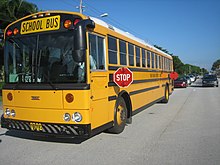
An American schoolhouse coach displaying front and rear folding stop signs
A stop sign on a pivoting arm is required equipment on Due north American schoolhouse buses. The sign normally stows flat on the left side of the bus, and is deployed past the commuter when opening the door for picking up or dropping off passengers. Some buses have 2 such terminate arms, ane nearly the front facing forwards, and ane almost the rear facing backwards. The stop sign is retroreflective and equipped either with cherry blinking lights above and below the terminate legend or with a fable that is illuminated by LEDs. Dissimilar a normal terminate sign, this sign indicates a two-way accented stop, requiring other vehicles travelling in both directions to remain stopped until the sign is retracted.[ citation needed ]
Europe [edit]
In Europe, stop signs are generally placed at sites where visibility is severely restricted, or where a loftier crash rate has been noted. In some European countries, terminate signs are placed at level crossings to mark the finish line. For most situations, Europe uses the requite way sign instead.[25] [26] All-style stops, which are common in North America, are exceedingly rare in Europe. Comparatively, roundabouts and priority to the right intersections are more mutual.
Uk [edit]
In the United Kingdom, finish signs may simply be placed at junctions with tramways or sites with severely restricted visibility.[27] Until 2016, each stop sign had to be individually canonical past the Secretary of State for Send.[28] [29] This requirement was removed by the 2016 amendments to the Traffic Signs Regulations and General Directions;[30] [31] the responsibility for blessing stop signs now lies with local authorities.
Section 79 of the Highways Human activity 1980 enables the government to improve visibility at junctions, as by removing or shortening walls or hedges. The Department for Ship considers improving visibility to be preferable to installing a stop sign.[27] The former UK practice of using "Halt" or "Slow" at Major Road Alee signs was discontinued in 1965 at the recommendation of the Worboys Committee.[32] Instead of replacing all the former halt signs with the new Vienna Convention stop sign, the give way sign became the standard one at UK priority junctions.[33]
Compliance requirements [edit]
Laws and regulations regarding how drivers must comply with a terminate sign vary past jurisdiction. In the The states and Canada, these rules are prepare and enforced at the state or provincial level. At a junction where 2 or more than traffic directions are controlled by finish signs, US and Canada practice generally has the commuter who arrives and stops outset keep first. If two or three drivers in dissimilar directions end simultaneously at a junction controlled past stop signs, generally the drivers on the left must yield the right-of-way to the driver on the far correct.
In all countries, the driver must come up to a consummate stop before passing a stop sign, even if no other vehicle or pedestrian is visible. If a end line is marked on the pavement, drivers must stop before crossing the line. Slowing but not completely stopping is called a "rolling finish", sometimes nicknamed subsequently a metropolis or region where it is considered endemic (east.grand., "Rhode Island roll" or "California terminate"[34]) – slowing down significantly but not stopping completely at the sign.[35] This partial stop is non acceptable to most constabulary enforcement officials, and can result in a traffic citation. Still, enforcement of this rule varies widely among countries. The automobile manufacturer Tesla removed a "rolling stop" feature from its cocky-driving software after the National Highway Traffic Safety Administration complained the practice is unsafe and illegal everywhere in the U.s..[36]
In some countries such as Czechia and Russia, stopping is required merely at a place where a driver has a sufficient view into the intersection, not at the edge of the intersection (where a "STOP" line is non present). Therefore, if multiple drivers come from the same management and all of them cease at appropriate place, they can continue without stopping over again.[37]
Bicyclists [edit]
In some jurisdictions, such as the U.S. state of Idaho, the traffic lawmaking allows for bicyclists budgeted a stop sign to slow down and yield to conflicting traffic, then proceed without stopping unless safety requires a full stop.[38] The Idaho law has been in consequence since 1982 and has not been shown to be detrimental to safety.[39] Since 2017, more states take implemented changes to the police similar to Idaho's: Delaware (2017),[twoscore] Oregon (2020), Washington (2020), Utah (2021) and N Dakota (2021). Cyclist advocacy groups take sought similar laws for other jurisdictions in the United states of america.[41] [42] [43]
Disadvantages [edit]
Terminate sign placement can pose difficulties and hazards in applications where cross traffic is not controlled past a sign or calorie-free. Relatively long distance between the terminate sign and the crossroad facilitates authentic perception of the speed of budgeted cross traffic, but lengthens the time and distance required to enter and clear the junction. Relatively short distance between the end sign and the crossroad shortens the time required for rubber passage through the intersection, simply degrades the ability of the stopped driver to accurately perceive the speed of approaching cross traffic. Specifically, drivers approaching an intersection from beyond the subtended angular velocity detection threshold (SAVT) limit may be perceived by a stopped driver equally standing yet rather than approaching,[44] which means the stopped commuter may not make an authentic determination as to whether it is safe to proceed past the stop sign.[45] Whether the distance between the stop sign and the crossroad is officially short or is shortened past drivers creeping by the terminate line, they can lose the visual acuity of lateral motion,[46] leaving them to rely on the SAVT.[45] This can make it hard to accurately estimate the motility of budgeted cross traffic.[45] [44] According to contempo game-theoretical analysis, at intersections where all directions face terminate signs, drivers have potent incentives to run the stop sign; A ameliorate solution is to randomly remove one stop sign from all directions, which could lead to significant efficiency gains while ensure safety traffic.[47]
Run into likewise [edit]
- All-way finish
- Assured Clear Altitude Ahead
- Road traffic safety
- Roundabout
- Rules of the road
- Stopping sight distance
- Traffic psychology
- Yield sign
References [edit]
- ^ Vienna Convention on Road Signs and Signals, 1968. United nations Publication. ISBN 978-92-1-116973-7
- ^ "UK Department of Send. Traffic Signs Transmission, Chapter 3: Regulatory Signs" (PDF). 9 September 2008. Archived from the original on i June 2010.
{{cite web}}: CS1 maint: bot: original URL condition unknown (link)(2.0 MB) - ^ New Zealand Transport Bureau. Traffic Control Devices Manual: General requirements for traffic signs Archived 17 Jan 2015 at the Wayback Machine, (963 KB)
- ^ "Standard Highway Signs manual, 2004 Metric edition" (PDF).
- ^ a b "Standard Highway Signs manual, 2004 English language edition" (PDF). (viii.49 MB)
- ^ a b c "Manual on Uniform Traffic Command Devices 2003, Section 2B". Mutcd.fhwa.dot.gov. Retrieved 11 March 2012.
- ^ "Standard Highway Signs transmission, 2004 Metric edition" (PDF). (viii.36 MB)
- ^ "The quest to blueprint a improve stop sign". 25 May 2010.
- ^ a b c d e f Signalfan. History of the Cease Sign in America. 1997.
- ^ Greenbaum, Hilary; Rubinstein, Dana (9 December 2011). "The Cease Sign Wasn't Always Ruddy". The New York Times . Retrieved x February 2013.
- ^ "Seventeenth and Eighteenth Reports of the State Highway Commission to the Governor of Virginia for the 20-1 months ending June 30, 1925" (Virginia Pike Committee, 1925) p.37
- ^ Felton, Ryan (fourteen Oct 2017). "Hither's Why End Signs Are Red". Jalopnik. Gawker Media. Retrieved 16 October 2017.
- ^ Manaul on Uniform Traffic Control Devices (PDF). Section of Commerce. 1954. p. 2. Retrieved 16 Oct 2017.
- ^ Transmission on Uniform Traffic Command Devices. 1948 Edition. Part 1A, Department 31. "[A cease sign] shall exist mounted and then that its lesser will be 2 i⁄2 feet above the crown of the roadway."
- ^ "Convention on Road Signs and Signals". United Nations Treaty Collection. United Nations.
- ^ Watanabe, June (20 September 2006). "Malls tin can erect non-red stop signs". Star-Message . Retrieved 29 December 2020.
- ^ "Répertoire des dispositifs de signalisation routière du Québec, Transports Québec". Mtqsignalisation.mtq.gouv.qc.ca. Archived from the original on 22 February 2012. Retrieved 11 March 2012.
- ^ "Canada, Quebec, Montreal, bilingual Stop sign Stock Photos". Masterfile.com. Retrieved 11 March 2012.
- ^ panneau ARRÊT, Office québécois de la langue française, granddictionnaire.com.
- ^ Photograph by Flickr.com user "imagesdistributioncanada"
- ^ "Traffic Signs Manual, Chapter 3: Regulatory Signs, Department 3.4" (PDF). Britain Department of Transport. 8 September 2008. (two.0 MB)
- ^ Some factors influencing the road behaviour of vehicle drivers. R.J. Smeed, United kingdom Route Research Laboratory. Operational Research Quarterly, Journal of the Operational Research Society, Birmingham, England, 1952.
- ^ "Driver behaviour and accident records at unsignalized urban intersections". Abishai Polusa, Department of Civil Engineering & Transportation Research Institute, Technion-State of israel Institute of Technology, Haifa 32000, Israel. June 1984. Available online 4 July 2002.
- ^ Bretherton, M. "Multi-Way Stops—The MUTCD Is Correct!" 1999 ITE Compendium of Technical Papers. Plant of Transportation Engineers, August 1999.
- ^ "Here'south Why In that location Isn't a Single Stop Sign in Paris". 1 October 2020.
- ^ "Dutch Traffic: Why the end sign is so rare in the netherlands". Dutch Language Weblog | Language and Culture of the Dutch-Speaking Earth. 28 June 2018.
- ^ a b "Chapter 3: Regulatory Signs". Traffic Signs Transmission (PDF). London: TSO. 2019. p. 18. ISBN978-0-11-553223-viii . Retrieved 27 Apr 2020.
- ^ UK Department of Send. Traffic Signs Manual, Affiliate three: Regulatory Signs, Section three.2, 9 September 2008
- ^ "The Traffic Signs Regulations and Full general Directions 2002". www.legislation.gov.united kingdom . Retrieved 27 April 2020.
- ^ "Annex A". DfT Circular: The Traffic Signs Regulations and General Directions 2016 (PDF). 2016. p. 76. Retrieved 27 Apr 2020.
- ^ "The Traffic Signs Regulations and General Directions 2016". www.legislation.gov.britain . Retrieved 27 April 2020.
- ^ Slap-up Uk. Written report of the Traffic Signs Committee [Chairman, Sir Walter Worboys], eighteen April 1963.
- ^ "New traffic signs demonstrated on road at Birmingham." The Surveyor and Municipal Engineer, vol 122, p880, 1963.
- ^ Rosenberg, Mike (30 September 2010). "Cheaper fines for right plough on red? No fashion, governor says". San Jose Mercury News . Retrieved 30 September 2010.
- ^ "Dictionary.com definition". Lexicon.reference.com. Retrieved eleven March 2012.
- ^ Tesla recalls autos over software that allows them to roll through stop signs
- ^ "Musím na stopce zastavit za dalším vozidlem? :: Autoškola Příkaský". www.autoskolaprikasky.cz.
- ^ "Bicycle-related Idaho Code" (PDF). Idaho Vehicle Code Championship 49, Chapter 7. Idaho Transportation Department. Retrieved 7 February 2013.
- ^ "Wheel Law University: Idaho Stop". The League of American Bicyclists. 22 August 2013.
- ^ "Delaware Code Online". delcode.delaware.gov . Retrieved 23 March 2021.
- ^ Maus, Jonathan (15 Jan 2009). "Sectional: BTA will go for "Idaho manner" stop sign law". BikePortland.org . Retrieved seven February 2013.
- ^ "Idaho-mode Cease constabulary". San Francisco Cycle Coalition. Retrieved 7 February 2013.
- ^ Cano, Ricardo (18 September 2021). "California cyclists could treat cease signs equally yields if 'Idaho Cease' bill becomes police". San Francisco Chronicle . Retrieved 19 March 2022.
- ^ a b Hershel Weinberger (nineteen February 1971). "Conjecture on the Visual Estimation of Relative Radial Motion". Nature. 229 (5286): 562. Bibcode:1971Natur.229..562W. doi:x.1038/229562a0. PMID 4925353. S2CID 4290244.
- ^ a b c Michael E. Maddox; Aaron Kiefer (September 2012). "Looming Threshold Limits and Their Use in Forensic Exercise". Proceedings of the Human Factors and Ergonomics Society Annual Coming together. 50 (ane): 700–704. doi:10.1177/1071181312561146. S2CID 109898296.
- ^ Joseph S. Lappin; Duje Tadin; Jeffrey B. Nyquist; Anne L. Corn (January 2009). "Spatial and temporal limits of move perception across variations in speed, eccentricity, and low vision". Journal of Vision. 9 (30): 30.i–14. doi:x.1167/ix.1.30. PMID 19271900.
Displacement thresholds for peripheral motion were afflicted by acuity limits for speeds beneath 0.five degrees/s.
- ^ Li, Jiasun (14 September 2022). "Four-Style Stops". Rochester, NY. SSRN 4197885.
External links [edit]
- History of Stop Signs
- Stop Sign Photo Gallery
- A Drove of Stop and Yield Signs
- Cease Sign Template
30 Feet From Stop Sign,
Source: https://en.wikipedia.org/wiki/Stop_sign
Posted by: harttaboure.blogspot.com


0 Response to "30 Feet From Stop Sign"
Post a Comment